Attached files
| file | filename |
|---|---|
| 8-K - 8-K - FIRSTENERGY CORP | a8-kdated09262016.htm |

Power & Gas Leaders Conference
Charles E. Jones, President and CEO
September 27, 2016
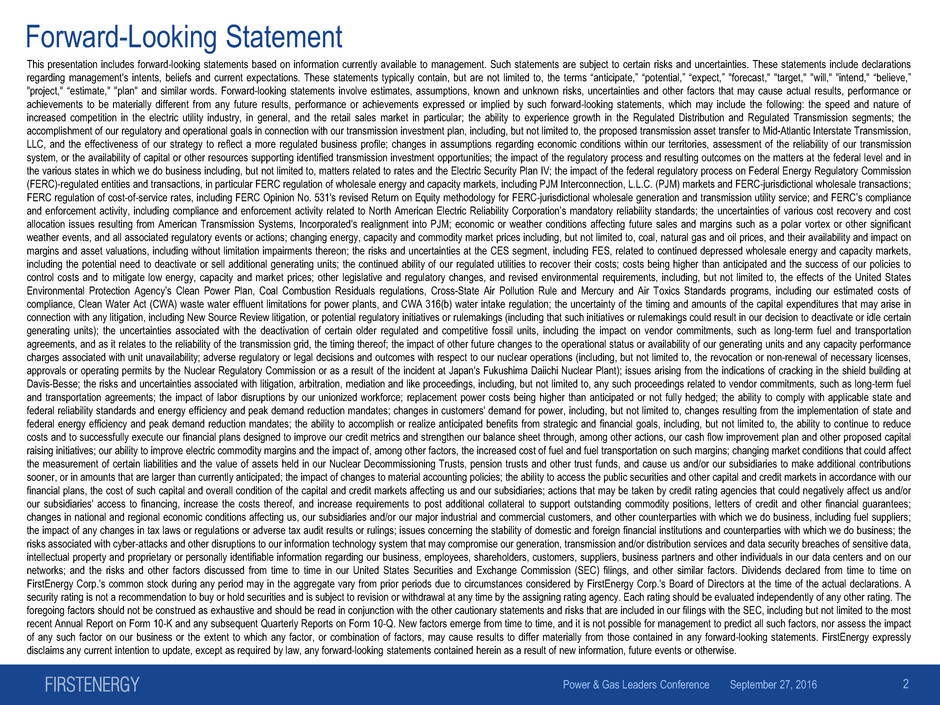
Forward-Looking Statement
September 27, 2016 Power & Gas Leaders Conference
This presentation includes forward-looking statements based on information currently available to management. Such statements are subject to certain risks and uncertainties. These statements include declarations
regarding management's intents, beliefs and current expectations. These statements typically contain, but are not limited to, the terms “anticipate,” “potential,” “expect,” "forecast," "target," "will," "intend," “believe,”
"project," “estimate," "plan" and similar words. Forward-looking statements involve estimates, assumptions, known and unknown risks, uncertainties and other factors that may cause actual results, performance or
achievements to be materially different from any future results, performance or achievements expressed or implied by such forward-looking statements, which may include the following: the speed and nature of
increased competition in the electric utility industry, in general, and the retail sales market in particular; the ability to experience growth in the Regulated Distribution and Regulated Transmission segments; the
accomplishment of our regulatory and operational goals in connection with our transmission investment plan, including, but not limited to, the proposed transmission asset transfer to Mid-Atlantic Interstate Transmission,
LLC, and the effectiveness of our strategy to reflect a more regulated business profile; changes in assumptions regarding economic conditions within our territories, assessment of the reliability of our transmission
system, or the availability of capital or other resources supporting identified transmission investment opportunities; the impact of the regulatory process and resulting outcomes on the matters at the federal level and in
the various states in which we do business including, but not limited to, matters related to rates and the Electric Security Plan IV; the impact of the federal regulatory process on Federal Energy Regulatory Commission
(FERC)-regulated entities and transactions, in particular FERC regulation of wholesale energy and capacity markets, including PJM Interconnection, L.L.C. (PJM) markets and FERC-jurisdictional wholesale transactions;
FERC regulation of cost-of-service rates, including FERC Opinion No. 531's revised Return on Equity methodology for FERC-jurisdictional wholesale generation and transmission utility service; and FERC’s compliance
and enforcement activity, including compliance and enforcement activity related to North American Electric Reliability Corporation’s mandatory reliability standards; the uncertainties of various cost recovery and cost
allocation issues resulting from American Transmission Systems, Incorporated's realignment into PJM; economic or weather conditions affecting future sales and margins such as a polar vortex or other significant
weather events, and all associated regulatory events or actions; changing energy, capacity and commodity market prices including, but not limited to, coal, natural gas and oil prices, and their availability and impact on
margins and asset valuations, including without limitation impairments thereon; the risks and uncertainties at the CES segment, including FES, related to continued depressed wholesale energy and capacity markets,
including the potential need to deactivate or sell additional generating units; the continued ability of our regulated utilities to recover their costs; costs being higher than anticipated and the success of our policies to
control costs and to mitigate low energy, capacity and market prices; other legislative and regulatory changes, and revised environmental requirements, including, but not limited to, the effects of the United States
Environmental Protection Agency’s Clean Power Plan, Coal Combustion Residuals regulations, Cross-State Air Pollution Rule and Mercury and Air Toxics Standards programs, including our estimated costs of
compliance, Clean Water Act (CWA) waste water effluent limitations for power plants, and CWA 316(b) water intake regulation; the uncertainty of the timing and amounts of the capital expenditures that may arise in
connection with any litigation, including New Source Review litigation, or potential regulatory initiatives or rulemakings (including that such initiatives or rulemakings could result in our decision to deactivate or idle certain
generating units); the uncertainties associated with the deactivation of certain older regulated and competitive fossil units, including the impact on vendor commitments, such as long-term fuel and transportation
agreements, and as it relates to the reliability of the transmission grid, the timing thereof; the impact of other future changes to the operational status or availability of our generating units and any capacity performance
charges associated with unit unavailability; adverse regulatory or legal decisions and outcomes with respect to our nuclear operations (including, but not limited to, the revocation or non-renewal of necessary licenses,
approvals or operating permits by the Nuclear Regulatory Commission or as a result of the incident at Japan's Fukushima Daiichi Nuclear Plant); issues arising from the indications of cracking in the shield building at
Davis-Besse; the risks and uncertainties associated with litigation, arbitration, mediation and like proceedings, including, but not limited to, any such proceedings related to vendor commitments, such as long-term fuel
and transportation agreements; the impact of labor disruptions by our unionized workforce; replacement power costs being higher than anticipated or not fully hedged; the ability to comply with applicable state and
federal reliability standards and energy efficiency and peak demand reduction mandates; changes in customers' demand for power, including, but not limited to, changes resulting from the implementation of state and
federal energy efficiency and peak demand reduction mandates; the ability to accomplish or realize anticipated benefits from strategic and financial goals, including, but not limited to, the ability to continue to reduce
costs and to successfully execute our financial plans designed to improve our credit metrics and strengthen our balance sheet through, among other actions, our cash flow improvement plan and other proposed capital
raising initiatives; our ability to improve electric commodity margins and the impact of, among other factors, the increased cost of fuel and fuel transportation on such margins; changing market conditions that could affect
the measurement of certain liabilities and the value of assets held in our Nuclear Decommissioning Trusts, pension trusts and other trust funds, and cause us and/or our subsidiaries to make additional contributions
sooner, or in amounts that are larger than currently anticipated; the impact of changes to material accounting policies; the ability to access the public securities and other capital and credit markets in accordance with our
financial plans, the cost of such capital and overall condition of the capital and credit markets affecting us and our subsidiaries; actions that may be taken by credit rating agencies that could negatively affect us and/or
our subsidiaries' access to financing, increase the costs thereof, and increase requirements to post additional collateral to support outstanding commodity positions, letters of credit and other financial guarantees;
changes in national and regional economic conditions affecting us, our subsidiaries and/or our major industrial and commercial customers, and other counterparties with which we do business, including fuel suppliers;
the impact of any changes in tax laws or regulations or adverse tax audit results or rulings; issues concerning the stability of domestic and foreign financial institutions and counterparties with which we do business; the
risks associated with cyber-attacks and other disruptions to our information technology system that may compromise our generation, transmission and/or distribution services and data security breaches of sensitive data,
intellectual property and proprietary or personally identifiable information regarding our business, employees, shareholders, customers, suppliers, business partners and other individuals in our data centers and on our
networks; and the risks and other factors discussed from time to time in our United States Securities and Exchange Commission (SEC) filings, and other similar factors. Dividends declared from time to time on
FirstEnergy Corp.'s common stock during any period may in the aggregate vary from prior periods due to circumstances considered by FirstEnergy Corp.'s Board of Directors at the time of the actual declarations. A
security rating is not a recommendation to buy or hold securities and is subject to revision or withdrawal at any time by the assigning rating agency. Each rating should be evaluated independently of any other rating. The
foregoing factors should not be construed as exhaustive and should be read in conjunction with the other cautionary statements and risks that are included in our filings with the SEC, including but not limited to the most
recent Annual Report on Form 10-K and any subsequent Quarterly Reports on Form 10-Q. New factors emerge from time to time, and it is not possible for management to predict all such factors, nor assess the impact
of any such factor on our business or the extent to which any factor, or combination of factors, may cause results to differ materially from those contained in any forward-looking statements. FirstEnergy expressly
disclaims any current intention to update, except as required by law, any forward-looking statements contained herein as a result of new information, future events or otherwise.
2
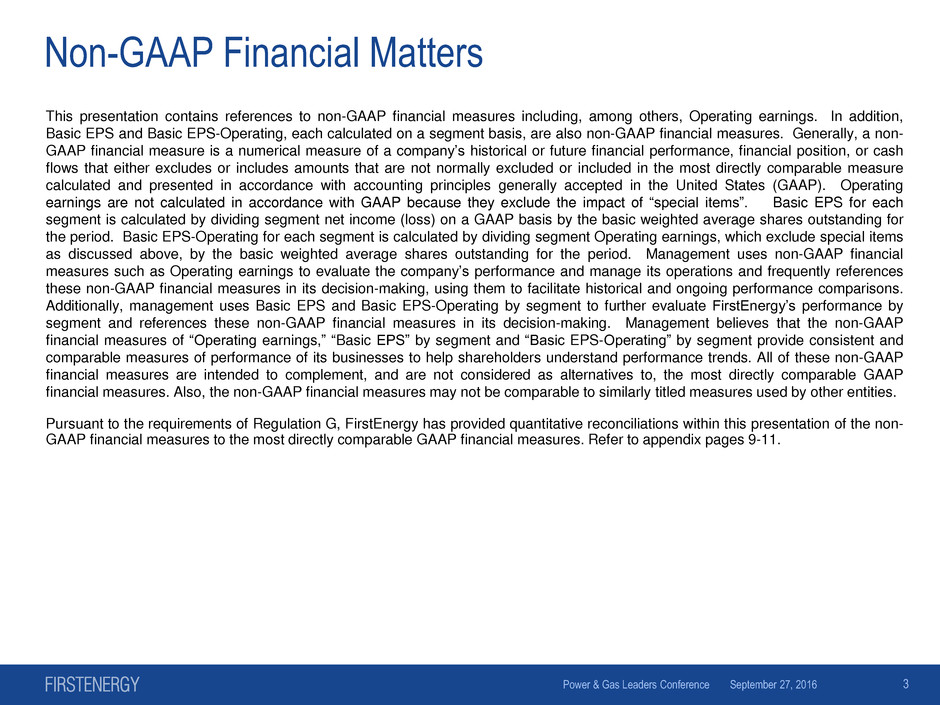
Non-GAAP Financial Matters
This presentation contains references to non-GAAP financial measures including, among others, Operating earnings. In addition,
Basic EPS and Basic EPS-Operating, each calculated on a segment basis, are also non-GAAP financial measures. Generally, a non-
GAAP financial measure is a numerical measure of a company’s historical or future financial performance, financial position, or cash
flows that either excludes or includes amounts that are not normally excluded or included in the most directly comparable measure
calculated and presented in accordance with accounting principles generally accepted in the United States (GAAP). Operating
earnings are not calculated in accordance with GAAP because they exclude the impact of “special items”. Basic EPS for each
segment is calculated by dividing segment net income (loss) on a GAAP basis by the basic weighted average shares outstanding for
the period. Basic EPS-Operating for each segment is calculated by dividing segment Operating earnings, which exclude special items
as discussed above, by the basic weighted average shares outstanding for the period. Management uses non-GAAP financial
measures such as Operating earnings to evaluate the company’s performance and manage its operations and frequently references
these non-GAAP financial measures in its decision-making, using them to facilitate historical and ongoing performance comparisons.
Additionally, management uses Basic EPS and Basic EPS-Operating by segment to further evaluate FirstEnergy’s performance by
segment and references these non-GAAP financial measures in its decision-making. Management believes that the non-GAAP
financial measures of “Operating earnings,” “Basic EPS” by segment and “Basic EPS-Operating” by segment provide consistent and
comparable measures of performance of its businesses to help shareholders understand performance trends. All of these non-GAAP
financial measures are intended to complement, and are not considered as alternatives to, the most directly comparable GAAP
financial measures. Also, the non-GAAP financial measures may not be comparable to similarly titled measures used by other entities.
Pursuant to the requirements of Regulation G, FirstEnergy has provided quantitative reconciliations within this presentation of the non-
GAAP financial measures to the most directly comparable GAAP financial measures. Refer to appendix pages 9-11.
September 27, 2016 Power & Gas Leaders Conference 3
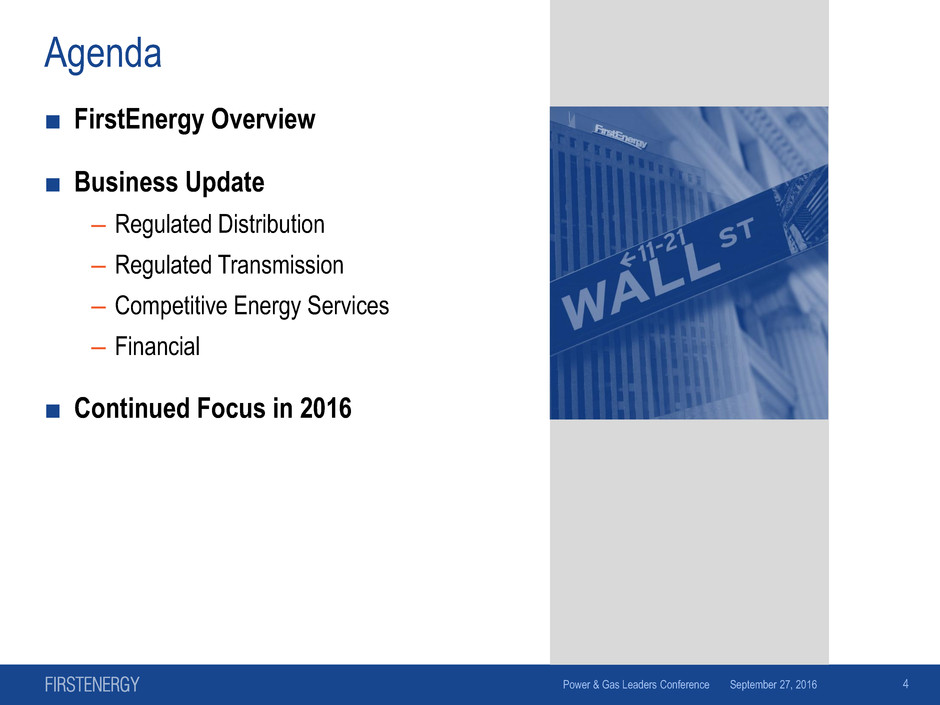
Agenda
■ FirstEnergy Overview
■ Business Update
– Regulated Distribution
– Regulated Transmission
– Competitive Energy Services
– Financial
■ Continued Focus in 2016
September 27, 2016 Power & Gas Leaders Conference 4
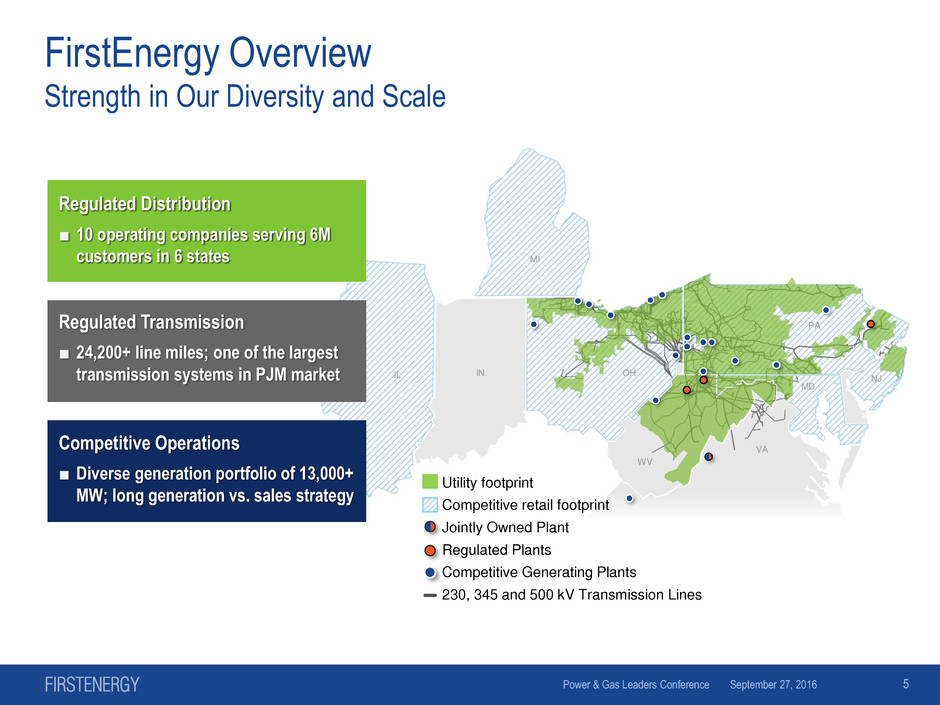
FirstEnergy Overview
Strength in Our Diversity and Scale
September 27, 2016 Power & Gas Leaders Conference 5
OH
VA
WV
PA
MD
NJ
MI
IN IL
Utility footprint
Competitive retail footprint
Jointly Owned Plant
Regulated Plants
Competitive Generating Plants
230, 345 and 500 kV Transmission Lines
Regulated Distribution
■ 10 operating companies serving 6M
customers in 6 states
Regulated Transmission
■ 24,200+ line miles; one of the largest
transmission systems in PJM market
Competitive Operations
■ Diverse generation portfolio of 13,000+
MW; long generation vs. sales strategy
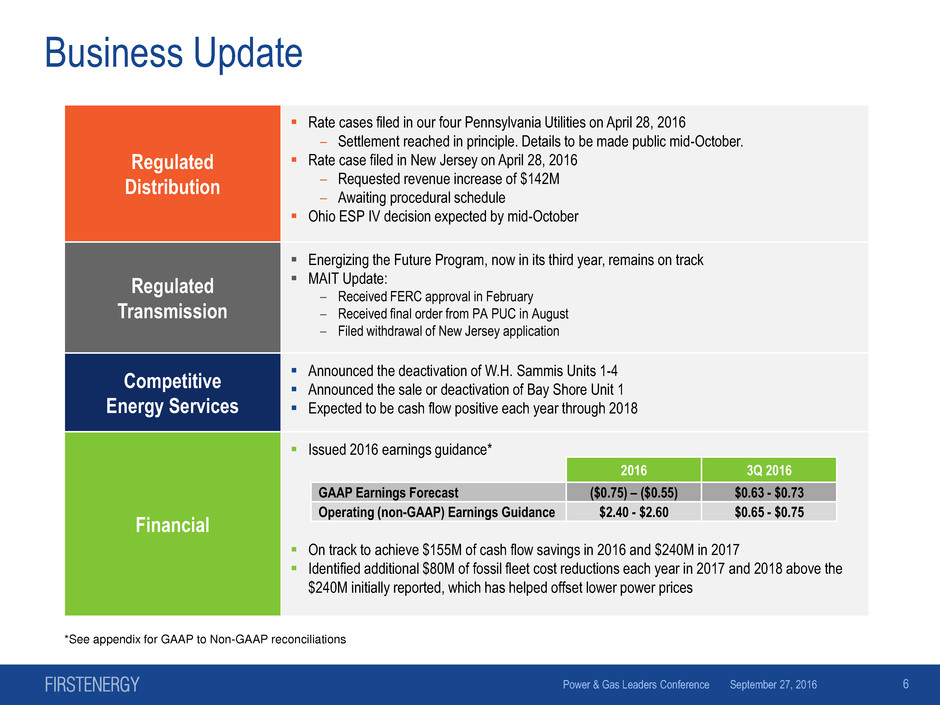
Business Update
September 27, 2016 Power & Gas Leaders Conference 6
Regulated
Distribution
Rate cases filed in our four Pennsylvania Utilities on April 28, 2016
– Settlement reached in principle. Details to be made public mid-October.
Rate case filed in New Jersey on April 28, 2016
– Requested revenue increase of $142M
– Awaiting procedural schedule
Ohio ESP IV decision expected by mid-October
Regulated
Transmission
Energizing the Future Program, now in its third year, remains on track
MAIT Update:
– Received FERC approval in February
– Received final order from PA PUC in August
– Filed withdrawal of New Jersey application
Competitive
Energy Services
Announced the deactivation of W.H. Sammis Units 1-4
Announced the sale or deactivation of Bay Shore Unit 1
Expected to be cash flow positive each year through 2018
Financial
Issued 2016 earnings guidance*
On track to achieve $155M of cash flow savings in 2016 and $240M in 2017
Identified additional $80M of fossil fleet cost reductions each year in 2017 and 2018 above the
$240M initially reported, which has helped offset lower power prices
2016 3Q 2016
GAAP Earnings Forecast ($0.75) – ($0.55) $0.63 - $0.73
Operating (non-GAAP) Earnings Guidance $2.40 - $2.60 $0.65 - $0.75
*See appendix for GAAP to Non-GAAP reconciliations
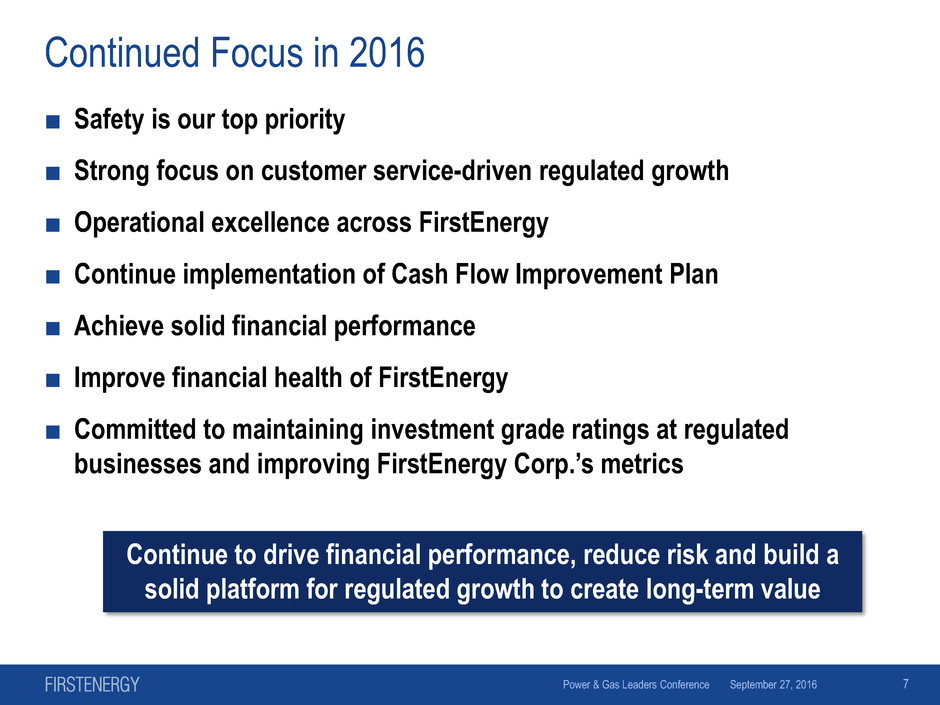
Continued Focus in 2016
■ Safety is our top priority
■ Strong focus on customer service-driven regulated growth
■ Operational excellence across FirstEnergy
■ Continue implementation of Cash Flow Improvement Plan
■ Achieve solid financial performance
■ Improve financial health of FirstEnergy
■ Committed to maintaining investment grade ratings at regulated
businesses and improving FirstEnergy Corp.’s metrics
September 27, 2016 Power & Gas Leaders Conference 7
Continue to drive financial performance, reduce risk and build a
solid platform for regulated growth to create long-term value

September 27, 2016 Power & Gas Leaders Conference 8
Appendix
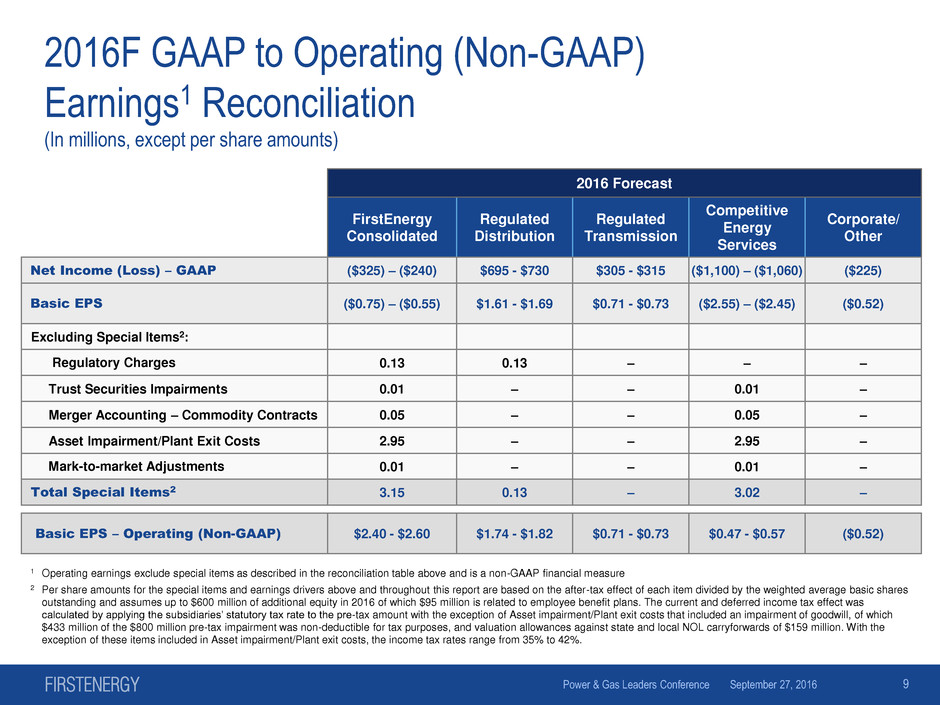
2016F GAAP to Operating (Non-GAAP)
Earnings1 Reconciliation
(In millions, except per share amounts)
September 27, 2016 Power & Gas Leaders Conference 9
2016 Forecast
FirstEnergy
Consolidated
Regulated
Distribution
Regulated
Transmission
Competitive
Energy
Services
Corporate/
Other
Net Income (Loss) – GAAP ($325) – ($240) $695 - $730 $305 - $315 ($1,100) – ($1,060) ($225)
Basic EPS ($0.75) – ($0.55) $1.61 - $1.69 $0.71 - $0.73 ($2.55) – ($2.45) ($0.52)
Excluding Special Items2:
Regulatory Charges 0.13 0.13 – – –
Trust Securities Impairments 0.01 – – 0.01 –
Merger Accounting – Commodity Contracts 0.05 – – 0.05 –
Asset Impairment/Plant Exit Costs 2.95 – – 2.95 –
Mark-to-market Adjustments 0.01 – – 0.01 –
Total Special Items2 3.15 0.13 – 3.02 –
Basic EPS – Operating (Non-GAAP) $2.40 - $2.60 $1.74 - $1.82 $0.71 - $0.73 $0.47 - $0.57 ($0.52)
1 Operating earnings exclude special items as described in the reconciliation table above and is a non-GAAP financial measure
2 Per share amounts for the special items and earnings drivers above and throughout this report are based on the after-tax effect of each item divided by the weighted average basic shares
outstanding and assumes up to $600 million of additional equity in 2016 of which $95 million is related to employee benefit plans. The current and deferred income tax effect was
calculated by applying the subsidiaries’ statutory tax rate to the pre-tax amount with the exception of Asset impairment/Plant exit costs that included an impairment of goodwill, of which
$433 million of the $800 million pre-tax impairment was non-deductible for tax purposes, and valuation allowances against state and local NOL carryforwards of $159 million. With the
exception of these items included in Asset impairment/Plant exit costs, the income tax rates range from 35% to 42%.
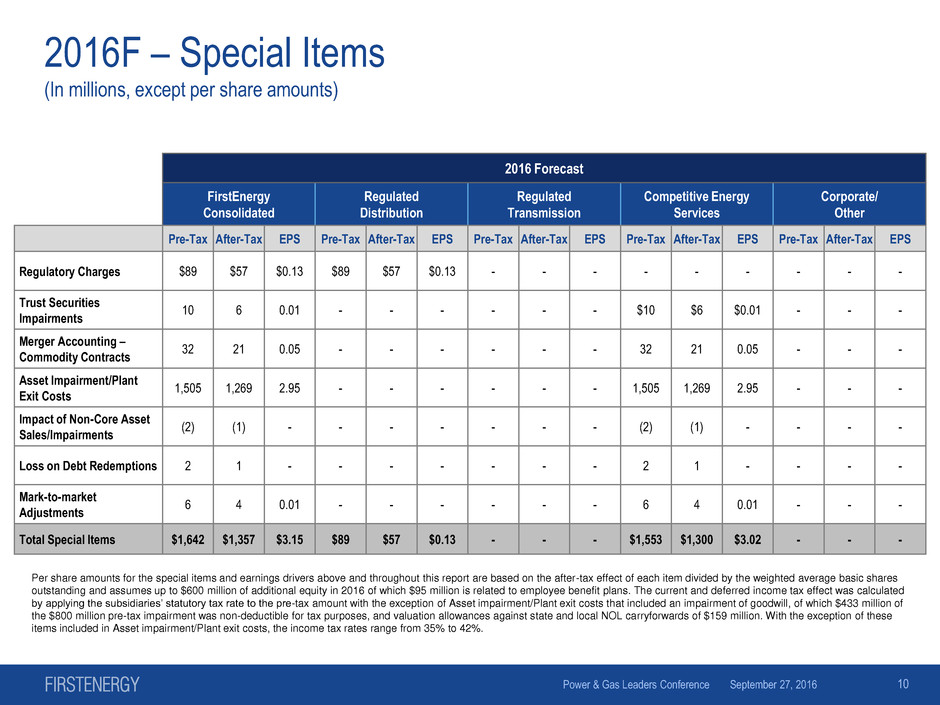
2016 Forecast
FirstEnergy
Consolidated
Regulated
Distribution
Regulated
Transmission
Competitive Energy
Services
Corporate/
Other
Pre-Tax After-Tax EPS Pre-Tax After-Tax EPS Pre-Tax After-Tax EPS Pre-Tax After-Tax EPS Pre-Tax After-Tax EPS
Regulatory Charges $89 $57 $0.13 $89 $57 $0.13 - - - - - - - - -
Trust Securities
Impairments
10 6 0.01 - - - - - - $10 $6 $0.01 - - -
Merger Accounting –
Commodity Contracts
32 21 0.05 - - - - - - 32 21 0.05 - - -
Asset Impairment/Plant
Exit Costs
1,505 1,269 2.95 - - - - - - 1,505 1,269 2.95 - - -
Impact of Non-Core Asset
Sales/Impairments
(2) (1) - - - - - - - (2) (1) - - - -
Loss on Debt Redemptions 2 1 - - - - - - - 2 1 - - - -
Mark-to-market
Adjustments
6 4 0.01 - - - - - - 6 4 0.01 - - -
Total Special Items $1,642 $1,357 $3.15 $89 $57 $0.13 - - - $1,553 $1,300 $3.02 - - -
Per share amounts for the special items and earnings drivers above and throughout this report are based on the after-tax effect of each item divided by the weighted average basic shares
outstanding and assumes up to $600 million of additional equity in 2016 of which $95 million is related to employee benefit plans. The current and deferred income tax effect was calculated
by applying the subsidiaries’ statutory tax rate to the pre-tax amount with the exception of Asset impairment/Plant exit costs that included an impairment of goodwill, of which $433 million of
the $800 million pre-tax impairment was non-deductible for tax purposes, and valuation allowances against state and local NOL carryforwards of $159 million. With the exception of these
items included in Asset impairment/Plant exit costs, the income tax rates range from 35% to 42%.
2016F – Special Items
(In millions, except per share amounts)
September 27, 2016 Power & Gas Leaders Conference 10
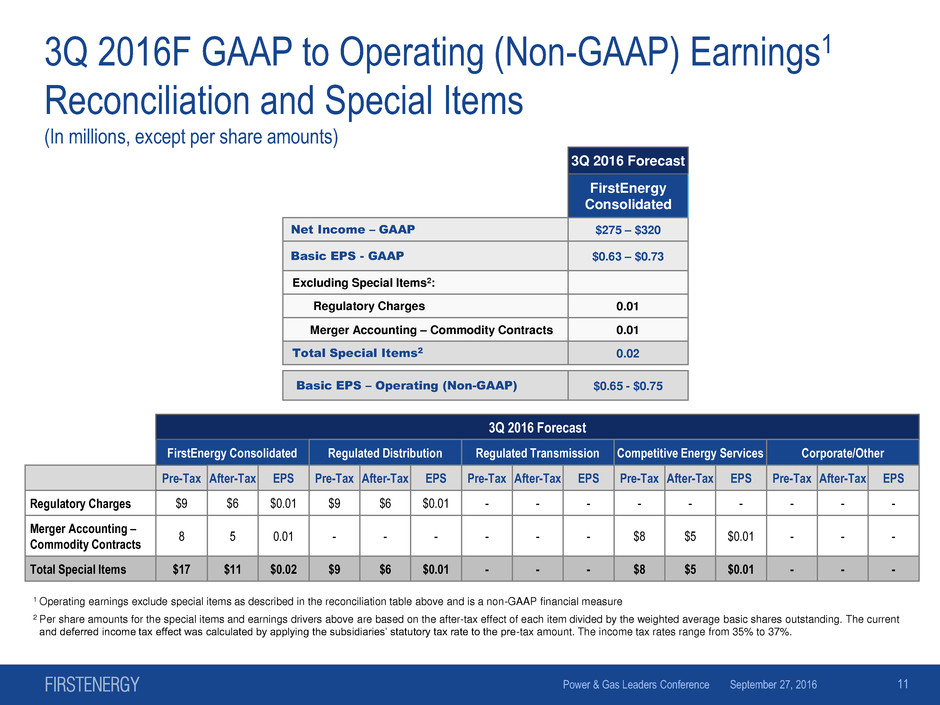
3Q 2016F GAAP to Operating (Non-GAAP) Earnings1
Reconciliation and Special Items
(In millions, except per share amounts)
September 27, 2016 Power & Gas Leaders Conference 11
1 Operating earnings exclude special items as described in the reconciliation table above and is a non-GAAP financial measure
2 Per share amounts for the special items and earnings drivers above are based on the after-tax effect of each item divided by the weighted average basic shares outstanding. The current
and deferred income tax effect was calculated by applying the subsidiaries’ statutory tax rate to the pre-tax amount. The income tax rates range from 35% to 37%.
3Q 2016 Forecast
FirstEnergy Consolidated Regulated Distribution Regulated Transmission Competitive Energy Services Corporate/Other
Pre-Tax After-Tax EPS Pre-Tax After-Tax EPS Pre-Tax After-Tax EPS Pre-Tax After-Tax EPS Pre-Tax After-Tax EPS
Regulatory Charges $9 $6 $0.01 $9 $6 $0.01 - - - - - - - - -
Merger Accounting –
Commodity Contracts
8 5 0.01 - - - - - - $8 $5 $0.01 - - -
Total Special Items $17 $11 $0.02 $9 $6 $0.01 - - - $8 $5 $0.01 - - -
3Q 2016 Forecast
FirstEnergy
Consolidated
Net Income – GAAP $275 – $320
Basic EPS - GAAP $0.63 – $0.73
Excluding Special Items2:
Regulatory Charges 0.01
Merger Accounting – Commodity Contracts 0.01
Total Special Items2 0.02
Basic EPS – Operating (Non-GAAP) $0.65 - $0.75
